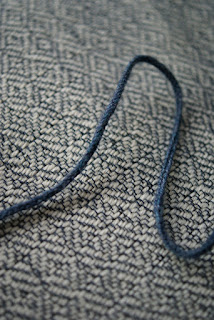The material at the Birka burials isn't Tenntråd, though. According to A. Geijer the spiral wires used for the posaments consisted either of a drawn gold or silver wire with a round cross section wrapped around a silk core:
"1. Drahtgold oder Drahtsilber: ein massiver, im Querschnitt runder Draht, der durch ziehen hergestellt ist. Es kann in der Stärke recht beträchtlich variieren.
2. Spiralgold oder Spiralsilber besteht aus einem derartigen Draht, der in dichten gleichmässigen Windungen um eine textile Seele gewunden ist, die jetzt aber meist vermodert ist. Diese Seele ist nur in etlichen sehr stark korrodierten Stücken mit Silber erhalten und konnte als Seide bestimmt werden; vermutlich wurde aber überall Seide als Stütze für die Spirale verwendet." (Geijer, A.: Birka III - Die Textilfunde aus den Gräbern, Almquist & Wiksells, Uppsala, 1938, p. 68.)
2. Spiralgold oder Spiralsilber besteht aus einem derartigen Draht, der in dichten gleichmässigen Windungen um eine textile Seele gewunden ist, die jetzt aber meist vermodert ist. Diese Seele ist nur in etlichen sehr stark korrodierten Stücken mit Silber erhalten und konnte als Seide bestimmt werden; vermutlich wurde aber überall Seide als Stütze für die Spirale verwendet." (Geijer, A.: Birka III - Die Textilfunde aus den Gräbern, Almquist & Wiksells, Uppsala, 1938, p. 68.)
So insdead of using the rather modern pewter wire from Scandinavia I wanted to try making my own spiral silver.
I made some attempts earlier, but since I dindn't have the right tools I was not very happy with the outcome.
The procedure of making the spiral wire seemed similar to that still used today by some Sami craftspeople. Obviously for big scale production of Tenntråd machines are used nowadays, but there are still people around who know how to make the wire by hand. I found this very helpful video from Norway, 1984:
https://www.nb.no/nbsok/nb/6f0a0f1eb2841bd2a98c1358864bb718.nbdigital?lang=no
For my own first experiment I used
- Kromski drop spindle, top-whorl, 85g
- Silver coated copper wire, 0,2mm
- Serafil 20, 100% polyester, z-plied
- Lazy Kate to hold the wire
I tied the core yarn to the spindle and started to wrap/z-spin the wire around the core, very much like core spinning with textile fibres. There were little gaps between the individual coils, so I had to stop after a while an push the coils down with my fingertips to get an uniform spiral wire.
When I had enough spiral wire for a test braiding, I went for a simple P9 Birka posament. The spiral wire I made was not as smooth to work with as the Tenntråd. I guess the copper work hardened while coiling it. So the next step will be to get some fine silver wire and real silk as core material.
But I'm quite happy with the overall outcome and the technique works very well to produce a considerable amount of spiral wire, which is needed to make Birka posaments.



















































